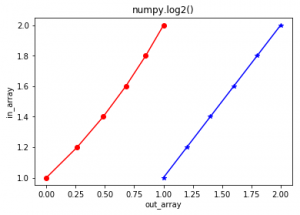📌 相关文章
- Python中的 numpy.log2()(1)
- Python中的numpy.log2(1)
- C++ log2()
- C++ log2()(1)
- C++中的log2()函数与示例(1)
- C++中的log2()函数与示例
- C++中的log2()函数与示例
- MySQL 中的 LOG2()函数
- MySQL 中的 LOG2()函数(1)
- Python PyTorch log2() 方法(1)
- Python PyTorch log2() 方法
- JavaScript数学log2()
- JavaScript数学log2()(1)
- JavaScript | Math.log2()函数(1)
- JavaScript | Math.log2()函数
- MySQL Math LOG2()函数
- 红宝石 |数学 log2()函数
- 红宝石 |数学 log2()函数(1)
- C++ STL-math.log2()函数
- C++ STL-math.log2()函数(1)
- matplotlib log2 xaxis - Python (1)
- matplotlib log2 xaxis - Python 代码示例
- Python -Numpy
- Python -Numpy(1)
- Python Numpy(1)
- Python Numpy
- numpy 的 - Python (1)
- numpy 示例 - Python (1)
- numpy 的 - Python 代码示例
📜 Python中的numpy.log2
📅 最后修改于: 2020-06-14 14:30:13 🧑 作者: Mango
numpy.log2(arr, out = None, *, where = True, casting = ‘same_kind’, order = ‘K’, dtype = None, ufunc ‘log1p’) :此数学函数可帮助用户计算以2为底的对数x其中x属于所有输入数组元素。
参数:
array: [array_like]输入数组或对象。
out: [ndarray,可选]输出数组,其尺寸与输入数组相同,并
放置在结果中。** kwargs:允许您将参数的关键字变量长度传递给函数。
当我们要处理函数中的命名参数时使用它。其中: [array_like,可选] True值表示
在该位置计算通用函数(ufunc),False值表示将
值保留在输出中。返回:
以2为底的对数值为x的数组;
其中x属于输入数组的所有元素。代码1:
# 解释log2()函数的Python程序
import numpy as np
in_array = [1, 3, 5, 2**8]
print ("输入数组 : ", in_array)
out_array = np.log2(in_array)
print ("输出数组 : ", out_array)
print("\nnp.log2(4**4) : ", np.log2(4**4))
print("np.log2(2**8) : ", np.log2(2**8)) 输出:
输入数组 : [1, 3, 5, 256]
输出数组 : [ 0. 1.5849625 2.32192809 8. ]
np.log2(4**4) : 8.0
np.log2(2**8) : 8.0代码2:图形表示
# Python程序显示log2()函数的图形表示
import numpy as np
import matplotlib.pyplot as plt
in_array = [1, 1.2, 1.4, 1.6, 1.8, 2]
out_array = np.log2(in_array)
print ("out_array : ", out_array)
plt.plot(in_array, in_array, color = 'blue', marker = "*")
# 红色代表numpy.log2()
plt.plot(out_array, in_array, color = 'red', marker = "o")
plt.title("numpy.log2()")
plt.xlabel("out_array")
plt.ylabel("in_array")
plt.show() 输出:
out_array:[0. 0.26303441 0.48542683 0.67807191 0.84799691 1.]
